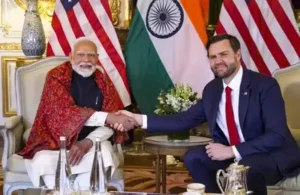
Vance Meets Modi in Delhi: Can They Seal a Deal to Dodge US Tariffs?
A Strengthening Bond: India and the U.S. Edge Closer to a Landmark Trade Deal
In a significant diplomatic development, U.S. Vice President JD Vance recently met Indian Prime Minister Narendra Modi in New Delhi, signaling a potential turning point in Indo-U.S. trade relations.
This high-level meeting, held during Vance’s largely personal four-day visit, focused on avoiding new American tariffs, negotiating a bilateral trade agreement, and bolstering ties under the Trump administration’s evolving foreign policy.
Progress in Talks, But Not Quite There Yet
While the visit had personal undertones — Vance was accompanied by his wife Usha Vance, a practicing Hindu with roots in India, and their three children — the agenda was firmly anchored in diplomacy and trade.
Both leaders reportedly reviewed ongoing progress in various sectors of cooperation, including defense, energy, and strategic technologies.
Statements from both sides acknowledged “significant progress” in trade negotiations. However, the White House clarified that while the talks laid a roadmap for further discussion, the deal itself remains in the works.
The Trump administration’s tariff strategy has, in part, catalyzed such negotiations, aiming to push for deals that counterbalance China’s growing influence.
A $500 Billion Vision
One of the standout highlights from the talks was the ambitious goal set by both nations — to more than double their bilateral trade to $500 billion by 2030. This target reflects not only the depth of the partnership but also the economic potential of the world’s largest democracies when aligned.
The U.S. is already India’s largest trading partner, and formalizing this relationship through a comprehensive trade agreement could unlock immense economic and geopolitical value for both countries.
Tariffs, Strategy, and Global Positioning
Vance’s visit occurred against the backdrop of Trump’s “partially-paused” tariff program — a 90-day suspension of a baseline 10% tax on imports. This pause provides a brief window for countries like India to engage in meaningful negotiations and potentially secure more favorable terms.
From Washington’s point of view, India plays a crucial strategic role in the Indo-Pacific, especially as a counterbalance to China. With India part of the Quad alliance (alongside the U.S., Japan, and Australia), it’s increasingly seen as a key player in resisting China’s regional dominance. Trump is even expected to attend a Quad summit in India later this year, underlining the growing partnership.

More Than Just Business
While diplomacy dominated headlines, Vance and his family also embraced India’s cultural richness. After touching down in Delhi, they were welcomed with a traditional Indian classical dance performance and visited spiritual and historical landmarks such as the Akshardham Temple, the Taj Mahal, and Amer Fort.
This blend of strategic talks and personal cultural immersion helped add a human dimension to a trip otherwise rooted in geopolitics.
India’s Role in the U.S. Strategy Against China
India’s value to the U.S. extends beyond trade. It’s a vital partner in Washington’s long-term efforts to curb Chinese influence. Modi and Trump’s established rapport, dating back to Trump’s first term, has facilitated a smoother revival of diplomatic channels. Modi was also among the first world leaders to meet Trump after his return to office, emphasizing India’s commitment to a “mega partnership.”
As both countries navigate complex global currents, their mutual alignment offers a vision of shared strength — economically, diplomatically, and strategically.
You may also like
Archives
Calendar
| M | T | W | T | F | S | S |
|---|---|---|---|---|---|---|
| 1 | 2 | 3 | ||||
| 4 | 5 | 6 | 7 | 8 | 9 | 10 |
| 11 | 12 | 13 | 14 | 15 | 16 | 17 |
| 18 | 19 | 20 | 21 | 22 | 23 | 24 |
| 25 | 26 | 27 | 28 | 29 | 30 | 31 |
Leave a Reply